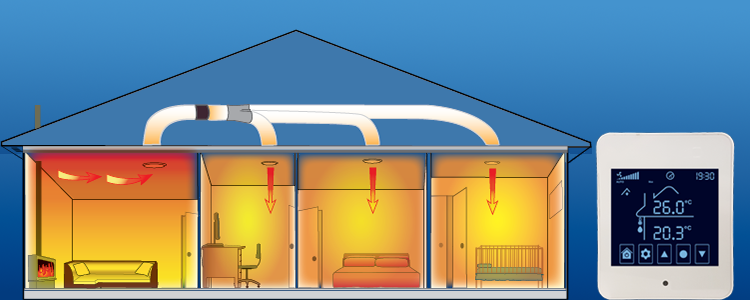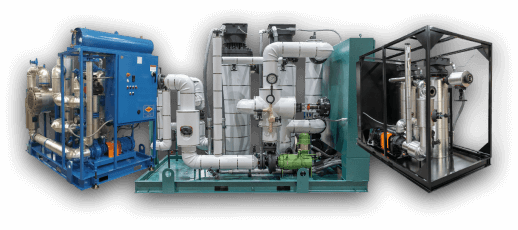Step-by-Step Installation Guide for DVS Heat Transfer Systems in Smart Manufacturing
The Function of Heat Transfer Equipments in Sustainable Energy Solutions for the Future
Heat transfer systems are important in the quest for sustainable power services. They optimize thermal power administration, improving the efficiency of renewable innovations. By using systems like conduction, convection, and radiation, these systems minimize power losses. Their function in solar thermal and geothermal applications is specifically considerable. As advancements arise, the possibility for additional developments elevates crucial questions concerning future energy approaches. What advancements will form the landscape of lasting power?
Recognizing Heat Transfer Equipments

The Relevance of Thermal Energy Administration
Effective thermal energy management is vital for optimizing energy effectiveness and lessening waste in numerous systems. By regulating temperature level and maximizing Heat transfer processes, companies can significantly reduce energy usage and functional prices. Reliable administration involves the application of innovative technologies and methods that keep an eye on and regulate thermal problems within systems, guaranteeing that power resources are utilized successfully. In enhancement, proper thermal energy monitoring adds to decreasing greenhouse gas emissions, aligning with worldwide sustainability objectives. It additionally enhances system reliability and performance, resulting in enhanced product high quality and longer devices life-span. Inevitably, prioritizing thermal power management is a vital step towards producing a lot more lasting power remedies and promoting an accountable method to power usage in industrial and household contexts.
Applications of Heat Transfer in Renewable Power
While numerous renewable resource resources promise sustainability, the efficient application of Heat transfer plays a vital function in their efficiency. In wind energy systems, Heat transfer is made use of for wind turbine component cooling, boosting efficiency and durability. Geothermal energy counts on efficient Heat exchange between the planet's subsurface and the fluid circulating in the system, maximizing power removal. Biomass energy processes likewise profit from Heat transfer, as it aids in transforming natural materials right into functional gas via pyrolysis and gasification. In addition, in hydropower, preserving optimal temperature levels in tanks can boost energy result. Each of these applications shows the important significance of Heat transfer systems in enhancing renewable resource innovations, ultimately contributing to a more lasting energy future.
Enhancing Solar Thermal Power Effectiveness
As solar thermal power systems continue to progress, enhancing their performance has actually come to be crucial for taking full advantage of power outcome. Developments in Heat transfer innovations, such as enhanced thermal storage products and ingenious Heat exchangers, play a substantial function in boosting performance. By using innovative materials that have premium thermal conductivity, systems can move and capture Heat extra successfully. Furthermore, integrating radar that adhere to the sun's path warranties that enthusiasts receive suitable solar exposure throughout the day. Making use of nanotechnology in solar absorbers can better increase energy absorption prices. Incorporating automatic control systems assists handle and control temperature levels energy distribution effectively, leading to minimized losses and enhanced total system effectiveness. These improvements lead the method for more lasting solar thermal power options in the future.
Geothermal Home Heating: A Sustainable Option
Geothermal home heating provides a feasible choice for lasting power, supplying substantial ecological benefits through lowered greenhouse gas discharges. Its performance and cost-effectiveness make it an eye-catching alternative to standard heater. However, challenges connected to execution has to be resolved to optimize its possible effect.
Environmental Advantages of Geothermal
Although standard heating techniques add significantly to greenhouse gas discharges, geothermal home heating offers an engaging choice that minimizes environmental influence. By harnessing the Earth's internal Heat, geothermal systems make use of a renewable energy resource, significantly lowering reliance on fossil gas. This method generates very little carbon exhausts, making it a cleaner choice for commercial and domestic heating. Furthermore, geothermal systems advertise power effectiveness, as they call for less energy compared to traditional heater. DVS Heat Transfer Systems. The use of geothermal energy likewise assists in minimizing air contamination, boosting neighborhood air quality and public health and wellness. As a lasting remedy, geothermal home heating sustains environment adjustment reduction efforts, placing itself as a crucial element in the change towards a greener future
Performance and Cost-Effectiveness
Just how does geothermal heating determine up in regards to performance and cost-effectiveness contrasted to traditional heating systems? Geothermal heating demonstrates superior efficiency, frequently achieving a coefficient of performance (COP) of 3 to 5, meaning it produces 3 to 5 systems of Heat for every unit of electrical power consumed. This performance converts into lower operating expense, particularly in areas with steady geothermal resources. First installment expenses can be greater than conventional systems; nonetheless, long-lasting cost savings on energy costs and lowered upkeep expenses can counter these in advance investments. In addition, many governments incentivize geothermal systems through discounts and tax credit reports, improving their cost-effectiveness. Overall, geothermal home heating becomes a lasting and economically sensible choice to more standard heating solutions.
Application Obstacles and Solutions
Various challenges can you could look here restrain the extensive implementation of geothermal heater, despite their clear advantages as a sustainable power solution. High initial setup prices typically prevent capitalists and home owners, making financing a significant barrier. In addition, the geographical constraints of ideal geothermal sites limit access in specific areas. Local guidelines and allowing processes can likewise make complex task development, causing hold-ups. Public recognition and understanding of geothermal systems remain reduced, preventing approval. To attend to these obstacles, targeted education and learning projects can enhance open secret, while federal government motivations could minimize monetary problems. Collaborating with regional authorities to enhance laws might promote smoother task authorizations, inevitably advertising the fostering of geothermal home heating as a sensible, lasting power option.
Developments in Heat Transfer Technologies
Developments in Heat transfer technologies play an essential duty in enhancing energy efficiency and sustainability. Advanced Heat exchangers and phase adjustment materials are at the forefront of these developments, offering substantial renovations in thermal administration. These innovations not only maximize power use however also add to reducing environmental effect in numerous applications.
Advanced Heat Exchangers
Advanced Heat exchangers play a crucial duty in improving energy performance throughout different applications in sustainable energy solutions. These tools facilitate the transfer of Heat between two or even more fluids, considerably lowering energy intake in processes such as industrial home heating, air conditioning, and power generation. Developments in materials and style, such as making use of nanofluids and compact configurations, have actually resulted in boosted thermal performance and lowered size needs. Furthermore, improvements in digital monitoring and control systems allow for maximized operation, additional increasing effectiveness. By minimizing waste Heat and maximizing power healing, progressed Heat exchangers add to reduce carbon impacts and support the shift towards eco-friendly innovations. Their proceeded development is important for accomplishing global energy sustainability goals.
Stage Adjustment Materials
The assimilation of phase modification materials (PCMs) into Heat transfer modern technologies stands for a considerable improvement in energy management and effectiveness. PCMs take in and launch thermal power throughout their stage modifications, enabling effective temperature guideline in building products and energy systems. By storing excess Heat during height durations and launching it when need rises, PCMs contribute to pack changing and power conservation - DVS Heat Transfer Systems. This ability enhances the performance of sustainable power systems, specifically in solar thermal applications. In addition, PCMs can boost the thermal convenience of interior continue reading this settings, reducing reliance on standard heating and cooling down techniques. As developments in PCM formulations continue to emerge, their role in lasting power options is poised to grow, providing appealing avenues for future research and application

Future Potential Customers for Heat Transfer in Lasting Energy
As the demand for lasting power solutions proceeds to rise, the duty of Heat transfer systems is becoming increasingly crucial fit future modern technologies. Innovations in layouts and products are anticipated to enhance efficiency in Heat transfer, lowering energy losses in various applications. The assimilation of advanced thermal storage systems, such as stage modification materials and thermochemical storage space, will certainly allow much better administration of energy resources. Study right into nanofluids and biomimetic Heat exchangers may even more optimize thermal performance. The why not try this out fostering of wise modern technologies will certainly enable for real-time tracking and adaptive control of Heat transfer procedures. These innovations are poised to substantially add to the overall efficiency and sustainability of energy systems, leading the method for a much more energy-efficient future.
Often Asked Questions
How Can People Execute Heat Transfer Systems in the house?

People can carry out Heat transfer systems in the house by mounting energy-efficient appliances, making use of glowing heating, and maximizing insulation. These steps enhance power performance, minimize costs, and advertise lasting practices in residential environments.

What Are the Costs Related To Setting Up Heat Transfer Solutions?
The expenses connected with installing Heat transfer systems differ commonly, typically encompassing tools, installment labor, and upkeep. Aspects such as system type, home size, and local policies significantly influence the total expenditure included.
Are There Government Incentives for Heat Transfer System Installations?
Federal government rewards for Heat transfer system setups vary by region and can consist of tax obligation gives, refunds, and credit reports. These financial advantages intend to encourage fostering, ultimately promoting power efficiency and reducing ecological impact within areas.
Exactly How Do Heat Transfer Systems Effect Energy Costs?
Heat transfer systems especially influence power expenses by optimizing power performance. By improving the transfer of Heat, these systems lower energy intake, causing lower utility prices and creating a more lasting technique to power monitoring.
What Maintenance Is Required for Heat Transfer Systems?
Upkeep for Heat transfer systems includes routine examinations, cleaning of elements, checking fluid degrees, ensuring appropriate insulation, and changing worn parts. These tasks aid maintain effectiveness, protect against break downs, and lengthen the system's functional life expectancy.
These systems promote the movement of thermal energy from one medium to another, making it possible for the transfer of Heat for energy, heating, or cooling generation objectives. Geothermal energy depends on efficient Heat exchange in between the planet's subsurface and the liquid flowing in the system, maximizing energy extraction. In addition, geothermal systems promote energy efficiency, as they need less energy compared to traditional home heating systems. Advanced Heat exchangers play an essential function in boosting energy performance throughout numerous applications in lasting energy options. Heat transfer systems especially affect power costs by maximizing power effectiveness.